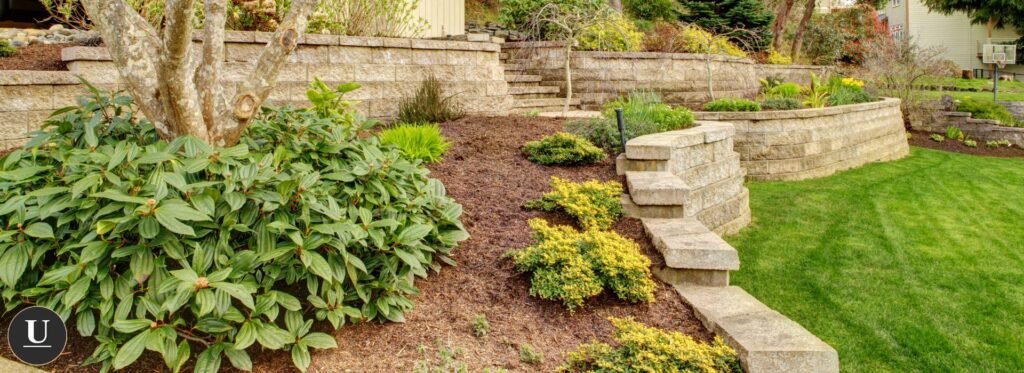Why Slopes Demand Specialized Landscaping
Slopes challenge every gardener. Rainwater rushing downhill causes soil erosion, washing away nutrients and leaving bare patches that are hard to plant. Unchecked runoff can carve channels and undermine any structure—whether it’s a pathway, a retaining wall, or your house’s foundation. Steep slopes often become unusable, with grass mowing dangerous or impossible. Smart landscaping on a slope means respecting these natural forces and applying both soft and hard solutions so your hillside stays stable and vibrant.
Assessing Your Slope: Planning Before You Plant
Before you dig or haul in rocks, take stock:
- Measure your slope grade (gentle <10%, moderate 10–20%, steep >20%).
- Identify where water pools or flows—those low places will need extra drainage.
- Test your soil type: sandy soils drain quickly but erode easily; clay soils hold water but can slide.
- Decide your goals: a tiered garden, a flat seating area, or a natural rock garden feature?
A clear assessment directs you to the right mix of terraces, drains, and plantings.
Soft Solutions: Mulch, Groundcovers & Gardening Techniques
Even a gentle slope benefits from soil erosion controls first:
- Mulch Blankets
3″ of organic mulch shields bare soil, slows water, and nourishes seedlings. - Groundcover Planting
Use deep-rooted species (creeping thyme, sedums, ivy) to bind earth. - Erosion Control Blankets
Biodegradable mats hold soil and mulch until roots take hold. - Straw Wattles & Logs
Lay straw rolls or logs across a hillside to slow runoff and trap sediment.
By layering mulch, groundcovers, and temporary erosion controls, you give plants time to stabilize the slope naturally.

Hard Solutions: Retaining Walls, Terraces & Rock Features
For moderate to steep slope landscaping, you need structure:
| Solution | Purpose | Key Term |
|---|---|---|
| Retaining Wall | Holds back soil, creates flat place | retaining walls |
| Terracing | Breaks slope into manageable tiers | tiers, slope |
| Rock Garden | Decorative, erosion-resistant | rock garden, rocks |
| Check Dams | Interrupts water flow | slope, water |
- Retaining Walls: Build with natural stone or concrete block, backfilled with gravel and drain pipe so water can escape.
- Terraces: Multiple low walls look natural and handle pressure better than one tall wall.
- Rock Gardens: Place rocks strategically to slow runoff and anchor plantings.
- Check Dams: Small rock or log barriers in drainage paths trap sediment and reduce channel erosion.
Planting Right: Selecting for Stability & Beauty
Plants are your silent partners in slope defense. A mix of groundcovers, shrubs, and trees creates layers of roots that hold soil:
- Groundcovers: Creeping phlox, periwinkle, grass turf alternatives for shallow slopes.
- Shrubs: Juniper, spirea, and shrubs with spreading roots for moderate slope areas.
- Ornamental Grasses: Switchgrass and fountain grass bind soil with fibrous roots.
- Trees: Dogwood or maple on larger slopes for deep anchoring roots.
Match planting choices to sun exposure: drought-tolerant on sunny banks, ferns and hostas in shady spots. Each area of your hillside can become a tapestry of color and texture.
Pathways & Access: Safe Gardening on Inclines
A garden is only enjoyable if you can reach it. Consider:
- Stone Steps: Flagstone or paver treads set into the hill for stable footing.
- Timber Risers: Treated wood steps that double as mini-retaining walls.
- Switchback Paths: Zigzag trails reduce grade for easier walking.
- Handrails: Essential for slopes over 25% to prevent falls.
Good access also helps with maintenance—no more balancing a mower on a dangerous grade.
Stormwater Management: Drains, Swales & French Drains
Controlling runoff is vital for slope longevity:
- French Drains: Perforated pipe behind walls diverts subsurface water safely away.
- Dry Creek Beds: Gravel-lined channels direct surface runoff toward designed exit points.
- Bioswales: Vegetated trenches that filter and slow stormwater.
By planning these features, you protect both the hillside and downstream landscaping from flooding.
Design Inspirations: Making Your Slope Shine
Elevate functionality with style:
- Terraced “Rooms”: Create distinct patio, garden, and play levels.
- Deck Overlook: Cantilevered deck offers flat area above the hillside.
- Water Features: A waterfall doubles as a controlled runoff solution.
- Night Lighting: Uplights on walls, path lights on steps, and spotlights on specimen rocks.
Your slope becomes a multi-dimensional experience—dynamic by day, magical by night.
Maintenance Tips: Caring for Your Hillside Investment
Keep your slope pristine with minimal effort:
- Annual Mulch: Refresh 2–3″ of mulch to curb soil erosion.
- Drip Irrigation: Gentle watering reduces runoff and targets plant roots.
- Wall Inspections: Check retaining walls for cracks and clear weep holes after rain.
- Weeding: Early removal prevents deep-rooted invaders from destabilizing the slope.
- Safety Checks: Ensure paths and steps remain slip-resistant.
A little regular care preserves decades of slope stability and beauty.
Ready to Tame Your Slope? Contact Urban Landscape & Construction
From preventing soil erosion to building stunning retaining walls and crafting a lush rock garden, our expert team handles every step of landscaping on a slope. Don’t let your hillside go to waste—contact us for a free consultation and let’s create a stable, beautiful garden haven that adds value and enjoyment to your property.
